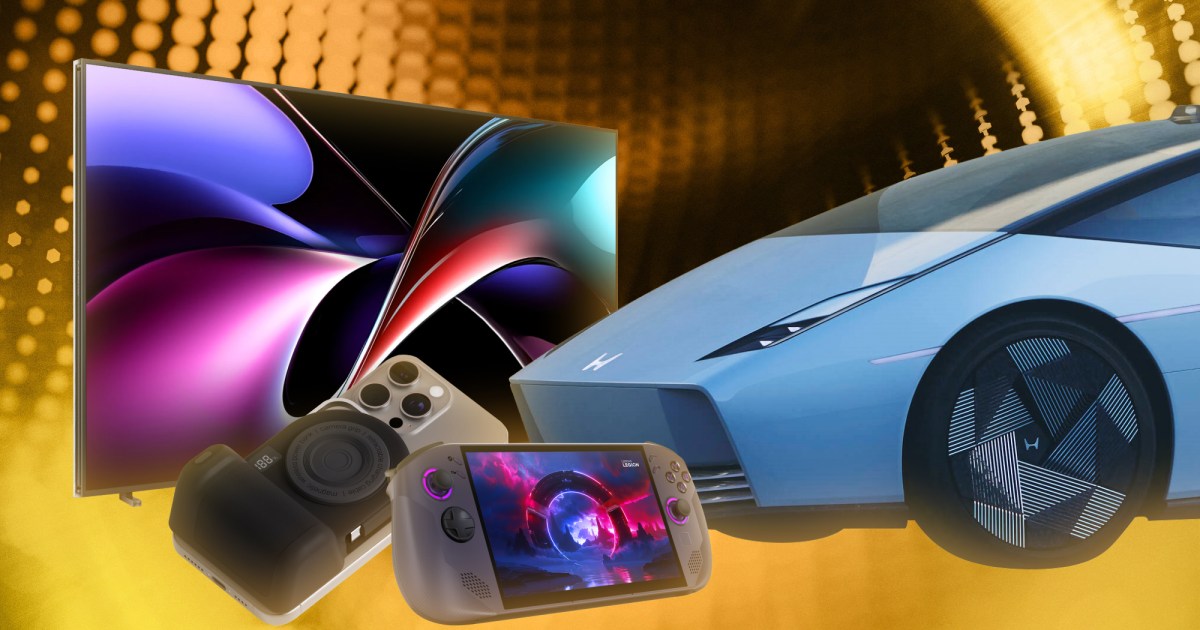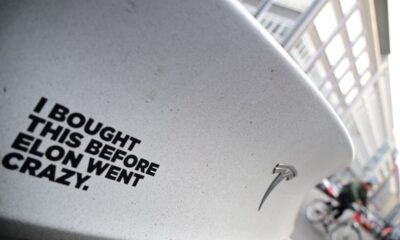Tech News
DailyTech’ Best of CES 2025 Awards

Las Vegas is overrun. Every billboard in town is shouting about AI, hotel bar tops now sport a sea of laptops, and after hours The Strip is elbow to elbow with engineers toting yard-long beers.
That means CES, the year’s biggest tech bacchanalia, has come to town, and DailyTech editors have spent the last four days frolicking among next year’s crop of incredible TVs, computers, tablets, and EVs. We’re in heaven.
With 4,500 exhibitors, there’s no way for any one person to see it all, but our team of editors has done its best to explore every backwater and annex of the Las Vegas Convention Center. We’re confident we’ve dug up the best of the best for our Best of CES 2025 awards. From monitors to smart gardens, desktop speakers to a really killer Steam Deck competitor, there’s something for everyone to get excited about here.
Computing
Lenovo Yoga Slim 9i
Wacky things have been done in the name of reducing bezels over the years. Ugly notches. Nosecams. Hidden or detachable cameras. Perhaps the worst solution is removing the webcam entirely. The latest version of the Lenovo Yoga Slim 9i, though, attempts an audacious technological leap to create an invisible webcam that can completely disappear from sight.
The solution is an incredible feat. When the camera is engaged, the OLED display turns off a small circle of pixels to allow the 32-megapixel camera located behind the screen to shoot through the panel and generate an image on the other side. Toss in a sprinkle of AI, and you have a half-decent camera feed for video calls. Is it a bit over-engineered? Maybe. But when you’re not bothering with your camera and you get to enjoy a bountiful sea of screen unencumbered by bezels and webcams, I don’t think you’ll mind.
– Luke Larsen
Asus PG27AQNR Pulsar gaming monitor
In the era of refresh rates above 500Hz, you’d think that the motion clarity issue for competitive gamers have been solved, but Asus’ PG27AQNR proves otherwise. It’s 360Hz and 1440p, but that’s not what’s special about it. The monitor is among the first to debut Nvidia’s G-Sync Pulsar tech.
It’s a big deal if you’re into competitive games. Essentially, Pulsar enables dynamic backlight strobing in a display, blanking out the image between refreshes based on what’s actually happening in your game. The result? You see a static image on each refresh, locking the target that you’re tracking into place for motion clarity that even the best OLED gaming monitors can’t match.
Although Pulsar isn’t angled toward every PC gamer, it’s a massive step forward for competitive gamers, and Asus is putting that on full display with the PG27AQNR.
– Jacob Roach
Samsung Odyssey 3D
You have every right in the world to be skeptical of a 3D gaming monitor. I know I was. But I’m telling you — as someone who’s tried out multiple generations of this technology over the years, the Samsung Odyssey 3D gaming monitor finally nails it.
The demo of The First Berserker I played feels like a huge advancement over the prototype technology we saw last year. Having your head in the “sweet spot” is no longer a factor, getting the full 3D effect in a much wider range of viewing angles and distances. Yes, there’s still a lot of work to be done to bring developers on board in time for release, or perhaps develop a 2D-to-3D conversion that actually works in games.
But the technology itself? It’s ready for showtime. Once gamers get a chance to see it for themselves, I have a feeling they won’t want to go back to the boring world of two dimensions.
– Luke Larsen
Asus Zenbook A14
A can of soup. A small pineapple. A pair of heavy socks. Google says those are a few household items that weigh about as much as the Asus Zenbook A14. At just 2.18 pounds, it’s the lightest laptop in recent memory — at least for a device that doesn’t completely sacrifice a major feature along the way. After all, when it comes to laptops, no one wants to sacrifice features, durability, ports, or functionality for lightness. The Zenbook A14 proves you can have the best of both worlds. When I picked this laptop up for the first time, I couldn’t believe how light it felt in my hand.
The entire laptop is made from Asus’ “high-tech ceramic” material — otherwise known as Ceraluminum — which provides its unique texture and its incredible lightness. All that, as is common with Asus, starts at under $1,000. That’s a winning combination, and it just might make for the ultimate laptop to travel with.
– Luke Larsen
Audio/Video
Hisense 116UX TriChroma LED TV
The Hisense 116UX does mini-LED in a new way. Instead of blue or white LED backlights shining through a color filter, the TriChroma LED TV uses tens of thousands of RGB Local Dimming optical lenses that each contain individual red, green, and blue LEDs. The lenses are then controlled in clusters, with dimming done at both the cluster and lens levels.
The individual RGB LEDs — without a color filter — allow the 116UX to achieve, according to Hisense, 97% of the BT.2020 color space. The RGB clusters are also more efficient, reducing power consumption.
We’re continuing to learn the intricacies about how the technology works, but it’s an obvious dynamic change to LED TV technology.
– John Higgins
Panasonic Z95B OLED TV
It was great to see Panasonic return to the U.S. market in 2024, and CES 2025 has shown that it’s back in earnest. While it has three new TVs for 2025, the flagship Z95B OLED caught our eye the most thanks to its incredible boost in brightness over last year’s Z95A.
Panasonic revealed that it’s using Primary RGB Tandem Panel technology — a new four-layer panel structure consisting of red, green, and blue (actually two blue) layers that allows for a better separation and purity of color and higher brightness, all without MLA (Micro Lens Array) technology. In addition, Panasonic engineers designed the ThermalFlow cooling system, inspired by aerodynamic race car design, to improve heat dissipation.
It’s a step forward in OLED panel design that we’ve been speculating about, and Panasonic has delivered it and shown us what it’s all about.
– John Higgins
TCL QM7K Mini-LED TV
There’s a lot of amazing TV tech at CES 2025, and the TCL QM7K definitely has its share. TCL has developed multiple improvements in its backlight technology, and the 2025 series of QM televisions (the QM7K included) are a part of the Precise Dimming Series. With a new chip, lens structure, decrease in the optical distance — from the backlight to the diffuser plate — and some processing improvements to virtually eliminate lag from input signal to backlight response, all aspects of the backlight performance on the QM7K looks to be improved over last year’s QM7.
Best of all, though, is that, unlike some of the other flashy TV tech on display, the QM7K will be a TV that fits within most people’s budgets. Even with all of the improvements, the QM7K is expected to be comparable in price to last year’s model (which started at $1,100) and we should see it sometime around midyear.
– John Higgins
Technics EAH-AZ100
If we were to give this award a sub-category, it might be “most improved wireless earbuds.” That’s because the Technics EAH-AZ100 are packed with improvements over their predecessors, the EAH-AZ80. Smaller, lighter, better ANC, better call quality, and way better battery life — all are strong reasons to recognize these new buds. They’ve even got spatial audio with head tracking and Auracast compatibility via Bluetooth LE Audio — two features the AZ80 lacked. But the kicker is their sound.
For the AZ100, Technics adapted its innovative Magnetic Fluid driver technology from its $1,100 wired IEMs, which gives the AZ100 ultra-low distortion and excellent sound quality.
Taken together, these changes make the Technics EAH-AZ100 the best wireless earbuds of CES 2025.
– Simon Cohen
Onkyo GX-30ARC
On the surface, Onkyo’s $299 powered desktop GX-30ARC speakers look like, well, speakers. But this is a case of good things coming in small packages. Onkyo’s decades of amplification heritage shines through in these speakers — they’re bi-amped, which means each driver gets a discrete source of power — and we suspect that’s a big reason for their powerful sound, which impresses with both its clarity and low-end authority.
They’re also loaded with input options, including USB-C, Bluetooth (with LE Audio and Auracast), optical, stereo RCA (with selectable line-in and phono settings), and an HDMI-ARC port, which gives the GX-30ARC part of its name.
Add to this package a magnetically attached grille, your choice of two colors, an included set of angled woodgrain stands, and a remote, and you’ve got a compelling set of powered speakers whether you’re a creator or just an avid listener.
– Simon Cohen
Mobile
Belkin Stage PowerGrip
Belkin is always a strong force at CES, but at CES 2025, it announced one of its most unique iPhone accessories to date: the Stage PowerGrip. What exactly is the Stage PowerGrip? Well, it’s a lot of things.
Imagine a 10,000mAh battery pack that attaches to your iPhone via MagSafe. And it has an integrated USB-C cable to charge other devices. And it acts as a stand to prop up your phone on a table. And it has a camera grip. And it has a camera shutter button. And it comes in some really lovely colors. That’s the Belkin Stage PowerGrip.
It’s really exciting to see this level of creativity from Belkin, and I hope we see even more of it in the years to come.
– Joe Maring
Lenovo Legion Tab Gen
-

 Destination7 months ago
Destination7 months agoSingapore Airlines CEO set to join board of Air India, BA News, BA
-

 Breaking News8 months ago
Breaking News8 months agoCroatia to reintroduce compulsory military draft as regional tensions soar
-

 Tech News11 months ago
Tech News11 months agoBangladeshi police agents accused of selling citizens’ personal information on Telegram
-

 Breaking News8 months ago
Breaking News8 months agoBangladesh crisis: Refaat Ahmed sworn in as Bangladesh’s new chief justice
-

 Guides & Tips9 months ago
Guides & Tips9 months agoHave Unlimited Korean Food at MANY Unlimited Topokki!
-

 Gaming8 months ago
Gaming8 months agoThe Criterion Collection announces November 2024 releases, Seven Samurai 4K and more
-

 Toys10 months ago
Toys10 months ago15 of the Best Trike & Tricycles Mums Recommend
-

 Tech News9 months ago
Tech News9 months agoSoccer team’s drone at center of Paris Olympics spying scandal


































